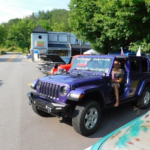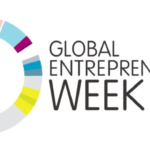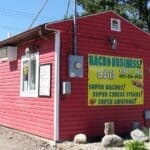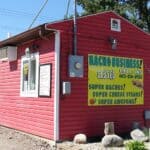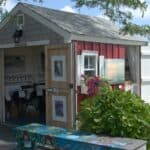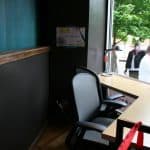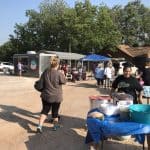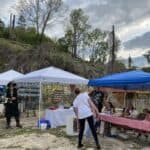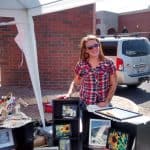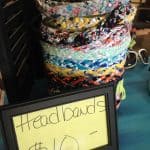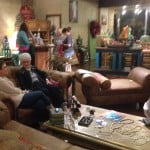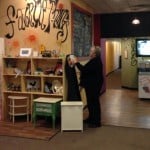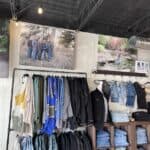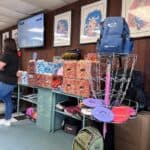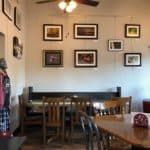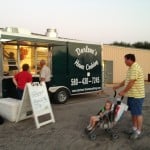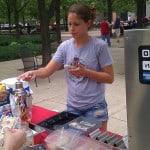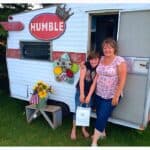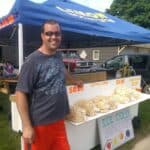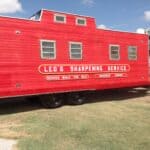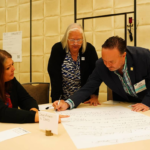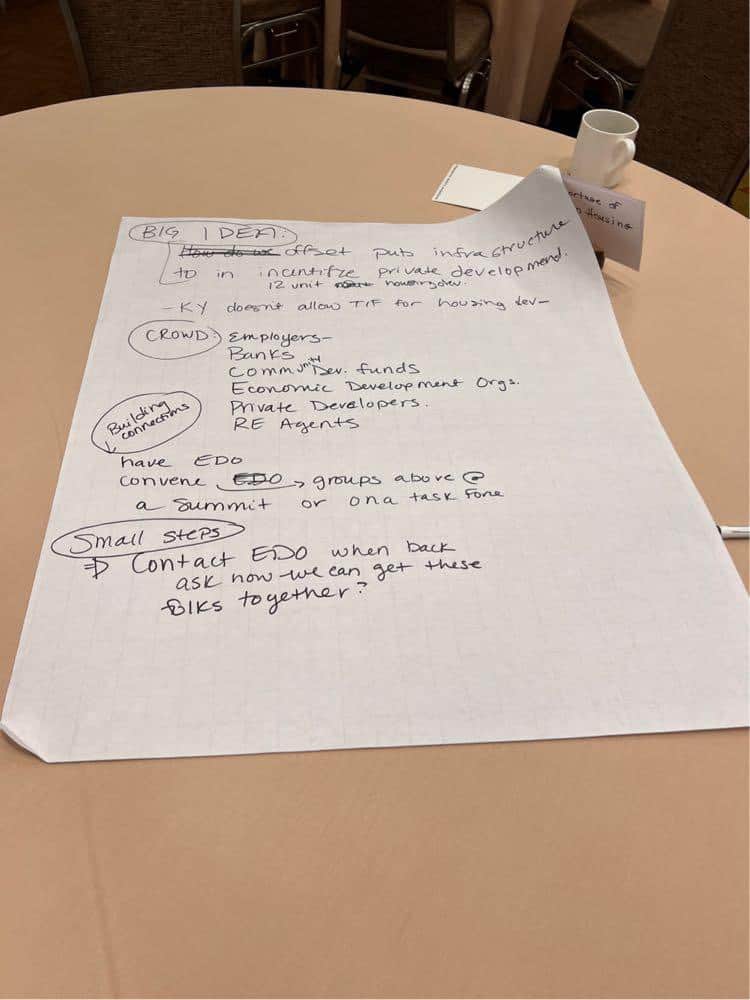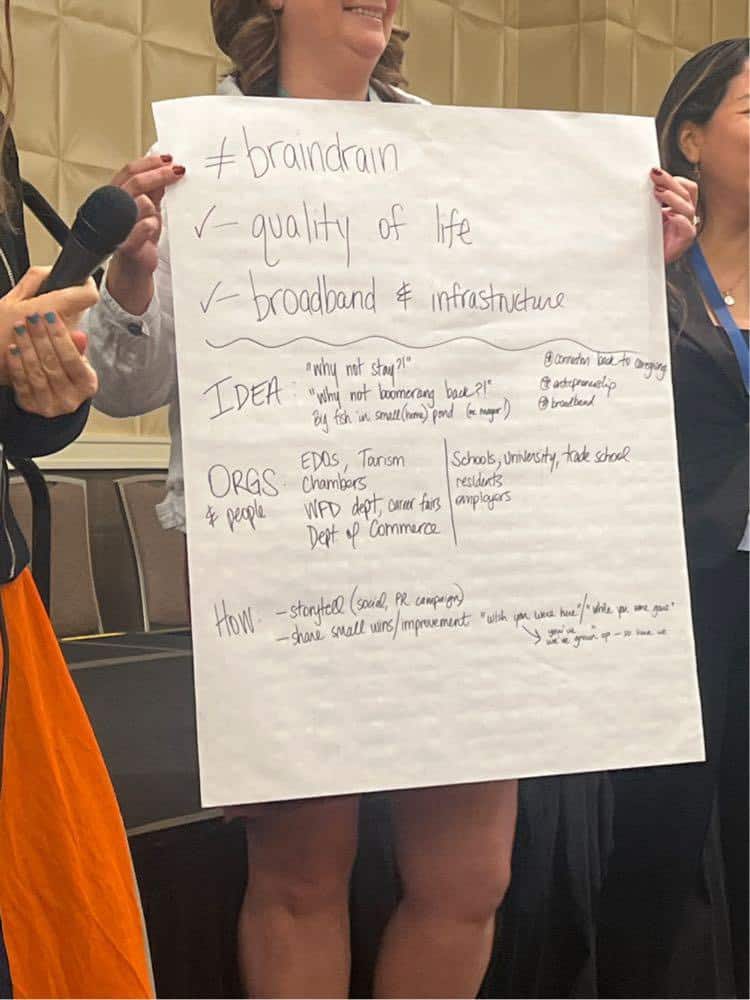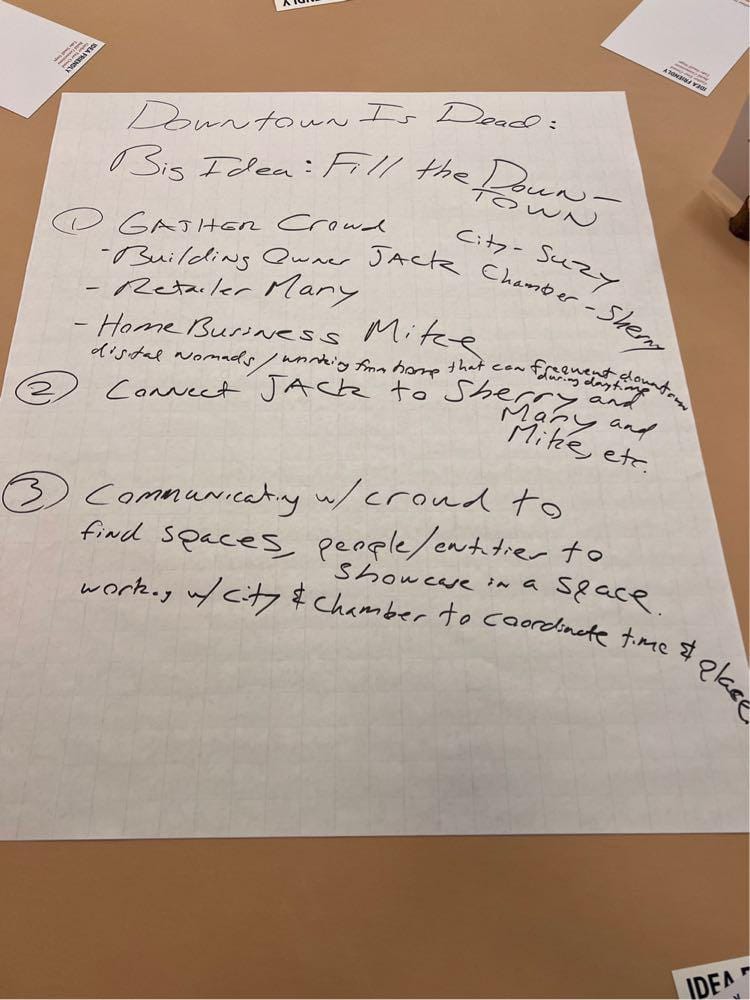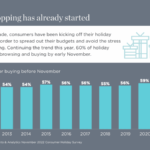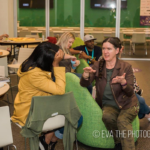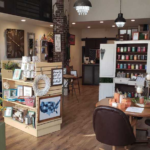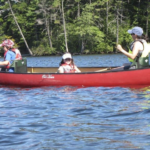Uncategorized
Innovative Rural Business Models: video
Part of our Global Entrepreneurship Week celebration Nov 13-19, 2023. Rural business people are trying a variety of different business models today, including pop-ups, shared buildings, businesses inside of other businesses and more. Entrepreneurs are using these smaller-scale experiments and tests to learn what works before making a huge investments. Learn how these Innovative Rural […]
Part of our Global Entrepreneurship Week celebration Nov 13-19, 2023.
Rural business people are trying a variety of different business models today, including pop-ups, shared buildings, businesses inside of other businesses and more. Entrepreneurs are using these smaller-scale experiments and tests to learn what works before making a huge investments. Learn how these Innovative Rural Business Models are being used right now in small towns in this video from the RuralRISE speaker series, featuring Becky McCray and Deb Brown, co-founders of SaveYour.Town
Innovative Rural Business Models, Becky McCray and Deb Brown, RuralRISE Virtual Speaker Series, 2023 (59 minutes)
Download the sample lease agreement (PDF)
The sample lease agreement for a shared building is one that we were given permission to share with others. Please have your own legal representative make a specific lease for your situation.
Would you like a presentation on the Innovative Rural Business Models?
Invite Deb and Becky to your town or event for a presentation or workshop.
Pop Up in An Empty Lot
Part of our Global Entrepreneurship Week celebration Nov 13-19, 2023. Starting a business the old way is hard On an Idea Friendly visit to Jackson County, Kentucky, I visited with a group of artists/entrepreneurs. This group had created a loose organization called the Jackson County KY Creative Community. They wanted to start businesses, but were […]
Part of our Global Entrepreneurship Week celebration Nov 13-19, 2023.
Starting a business the old way is hard
On an Idea Friendly visit to Jackson County, Kentucky, I visited with a group of artists/entrepreneurs. This group had created a loose organization called the Jackson County KY Creative Community. They wanted to start businesses, but were not ready to get a building and go through the extensive process of starting a business. Some needed to see if their work had a market and value to the customer. They felt stuck. Product and excitement, but no money to get their businesses off the ground.
Smaller steps to try first
We had gathered in an art studio in McKee, KY. There was lots of discussion around taking smaller steps to start your business.
- You could sell online in places like Etsy or eBay.
- You could ask a local business if you could have just one shelf to sell your product on.
- Or showcase your artwork on an empty wall in a place like the bank, or the insurance agents office.
- You could set up a card table at an event and sell from there.
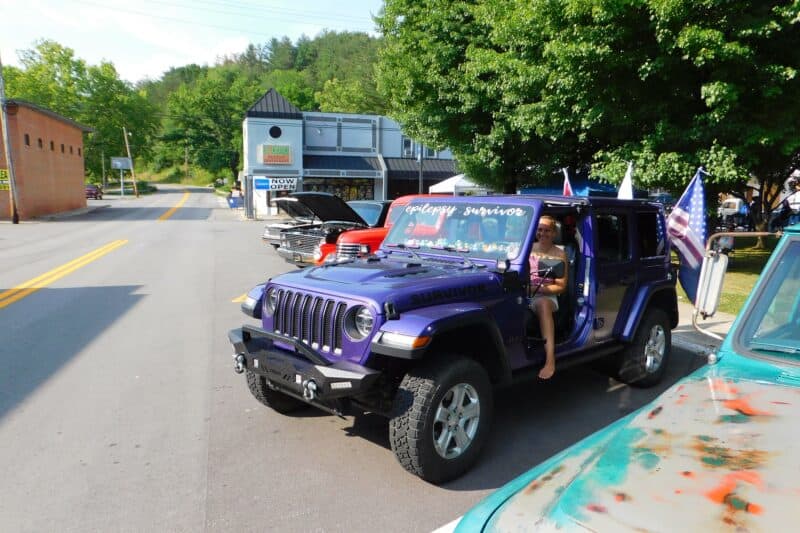
Downtown McKee, KY, car show photo by Anthony Jackson
Try using an empty lot
The group shared there was a car show coming to town soon. How could they piggyback on that event? There was an empty lot right downtown on the main highway, right across from where the cars would be parked. It wasn’t the best looking lot, it needed some attention. There was kudzu climbing the walls of buildings next to it, graffiti on the same buildings and the weeds needed some major whacking.
Ask
Kathy Spurlock owned the empty lot. I had already visited with her. I knew her time was already stretched thin, and her funds were being used for other community projects. Still, there was this empty lot waiting to be filled.
I asked her if the artists in the Jackson County KY Creative Community could possibly use it for a popup.
She said yes
The empty lot pop up was created! One artist’s husband took his weedwhacker and cleaned out an area just big enough for pop-ups. Everyone in the group spread the word a pop up was coming through social media and word of mouth. Other artists were invited. Signs were posted around the county. No one person was in charge, everyone participated as best they could.
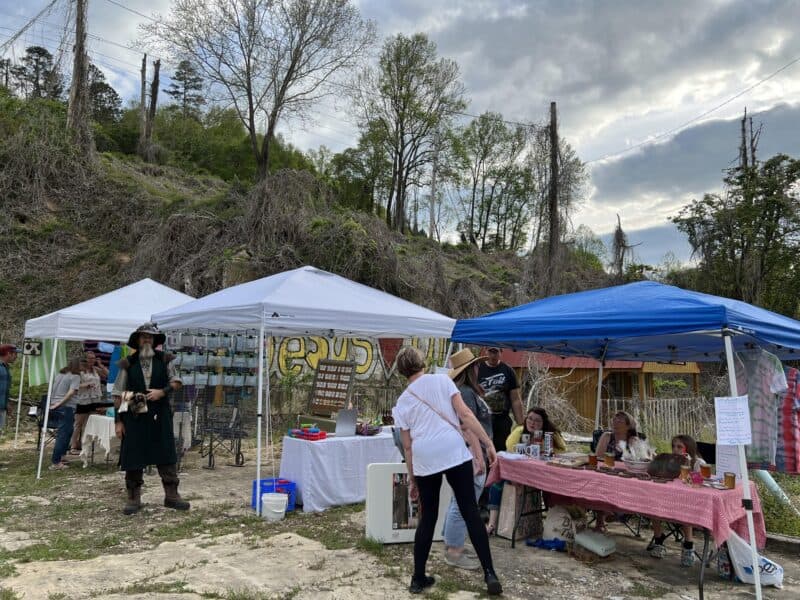
Empty Lot Pop Up photo by Greg Lakes
It worked!
There were many entrepreneurs set up with their works displayed. Folks came and bought from them, enjoyed the car show, and ate some food from local vendors. The Jackson County Creative Community added more artists as members too. There were lessons learned.
- You can pop up anywhere.
- It’s a good idea to join in another event and promote them both for more attendees.
- People are looking for something new and unique to do. Your excitement brings them in.
- Entrepreneurs come in all shapes and sizes and offering this kind of small step helps create more businesses in your community.
- Business can be conducted in unusual locations and empty lots are great testing grounds.
- It’s a small step. If it doesn’t work, you haven’t lost anything.
Entrepreneur week advice for small towns: 3 practical steps for economic developers and chambers of commerce
Part of our Global Entrepreneurship Week celebration Nov 13-19, 2023. Last year during entrepreneurship week, I saw lots of articles about what big cities can do to support entrepreneurship. Advice for small towns got left out. Again. So I wrote this entrepreneur week advice for small town economic developers and chambers of commerce, whether you […]
Part of our Global Entrepreneurship Week celebration Nov 13-19, 2023.
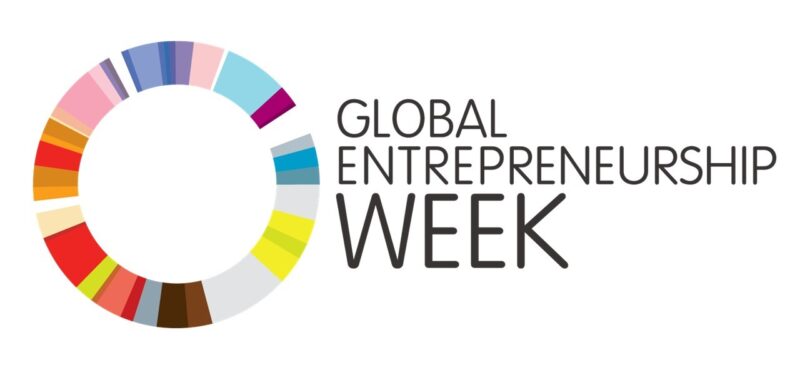
Last year during entrepreneurship week, I saw lots of articles about what big cities can do to support entrepreneurship. Advice for small towns got left out. Again.
So I wrote this entrepreneur week advice for small town economic developers and chambers of commerce, whether you serve 5,000 or 500 in your local population.
1. Create small spaces for entrepreneurs
Divide big buildings into shared retail spaces, garage-sized shops, small storage rooms for makers, and super affordable coworking for offices. These smaller spaces help keep startup costs down so entrepreneurs can grow to their next step. Then if a next step doesn’t work out, it didn’t require big financing and failure doesn’t have to mean financial ruin.
2. Recognize your artists and artisans as entrepreneurs with real economic value.
Support their efforts to sell online and at regional events. Create and support shared artist studios, workshops and galleries. Incorporate local artists into events and celebrations. Pay local artists and artisans for their work and creations.
3. Boost your food business ecosystem.
Find out about and support your growers, farmers, processors and markets. Expand the market for local foods by getting more local foods in front of more people. This includes your local residents and your visitors because both groups love to eat local.
Deb Brown and I made a 25 minute video on Food Business Ecosystems that is available for purchase at SaveYour.Town
Rural entrepreneurs start small to succeed: Global Entrepreneurship Week
Part of our Global Entrepreneurship Week celebration Nov 13-19, 2023. Find this and other Global Entrepreneurship Week events listed on the official calendar at GenGlobal. The old way to go into business Imagine all the work that goes into starting a new business. You need to be a good business manager, a marketing guru, and a […]
Part of our Global Entrepreneurship Week celebration Nov 13-19, 2023.
Find this and other Global Entrepreneurship Week events listed on the official calendar at GenGlobal.
The old way to go into business
Imagine all the work that goes into starting a new business. You need to be a good business manager, a marketing guru, and a financial wizard. You need to have great credit, have plenty of your own money, and you better know the right people. You need to have all your ducks in a row.
It takes a lot of time, money and work just to get into business.
The new way is to start small
Now imagine building some steps in between. If you could buy just a few products and test them by renting a booth at a festival, you’d learn more about what works. You could run a temporary business inside another business for a month or two for more testing. You could outfit a travel trailer as a store and set up a circuit of small towns, building a customer base. If something doesn’t work, you can fix it and try again. Now jumping up to starting a traditional store doesn’t seem as hard. You’ve learned what people want to buy. You’ve established relationships with suppliers. You’ve gained a loyal following. All those smaller steps lift you up closer to jumping over that hurdle of starting a traditional business. And if you miss a jump at a smaller step, it’s easier to recover and try something new.
That’s the purpose of the innovative rural business models. They put you in a much better position to succeed, or to fail in a manageable way. It cuts time and money off the process of getting into business.
You don’t need to have all your ducks in a row, as long as you can find one of your ducks and get started.
The Innovative Rural Business Models
First is TINY
- Rather than expect your business to start full-sized, it’s much easier to start something small. With tiny retail shops, tiny food kiosks, tiny industrial spaces, tiny offices, and tiny artist studios, starting small takes fewer resources, and puts your fragile new entrepreneur idea at less risk from big failures.
Second is TEMPORARY
- Rather than expect to start with a permanent business, try a pop-up. A temporary business will give you immediate feedback on whether there’s even a market for this idea.
Third is TOGETHER
- Rather than sink or swim on your own, start thinking about how to nurture your new business inside an existing business. This can be retailers splitting a space, or a startup using an extra office desk in a service business, or even nurturing a tiny maker inside of an existing manufacturing business. Small towns have fewer usable buildings, so we have to make the best use of every usable building we have.
Fourth is TRAVELING
- You’re used to seeing food businesses operating out of trucks and trailers, but this idea has expanded. Rather than depending on the market in one town only, innovative businesses are hitting the road to round up customers. Retail stores and boutiques now commonly operate from a truck or trailer. Service businesses are using this model, too: wedding planners, financial consultants, and dog groomers.
Share your own story
You can add your own story, too. What have you learned about rural small business? What’s working in your own business and your own community? What have you learned to avoid?
Leave a comment or use our contact form to share, and I’ll reach out to follow up.
This is global. Stories from anywhere rural are welcome.
Solve Rural Community Challenges the Idea Friendly Way – stories from IEDC
Guest post by Deb Brown What attendees learned from attending the Idea Friendly Session by SaveYour.Town at the International Economic Development Council Conference — Big Ideas you can copy in your town Becky McCray and I were excited to lead an interactive Idea Friendly workshop at the International Economic Development Council Conference in Dallas in […]
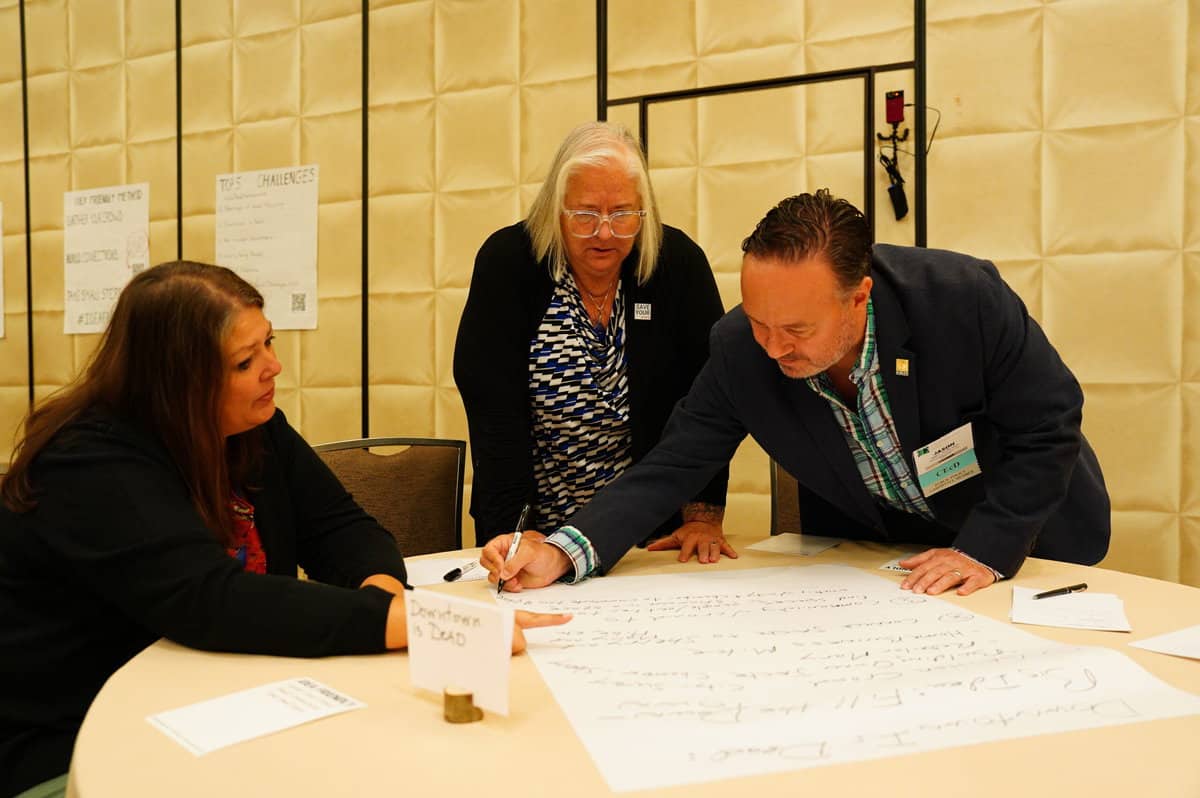
Photo courtesy of IEDC
Guest post by Deb Brown
What attendees learned from attending the Idea Friendly Session by SaveYour.Town at the International Economic Development Council Conference — Big Ideas you can copy in your town
Becky McCray and I were excited to lead an interactive Idea Friendly workshop at the International Economic Development Council Conference in Dallas in September of 2023.
The Idea Friendly Method is:
- You gather your crowd with a big idea.
- You turn that crowd into a capable network through building connections.
- You and the crowd accomplish the big idea through small steps.
What Happened in the Idea Friendly Workshop
Attendees developed their own Idea Friendly Projects after learning what Idea Friendly is and how to use it effectively in rural communities.
Engaging the audience, we asked what their rural challenges were. Not surprisingly, they aligned with the top 5 rural challenges on our Survey of Rural Challenges results:
- Shortage of good housing
- Downtown is dead
- Not enough volunteers
- Losing Young People
- Lack of Childcare
The attendees broke off into groups and chose a challenge to work on together. Each table had a flipchart sheet and the group worked the challenge through the Idea Friendly Method. The different groups presented their results to the entire room.
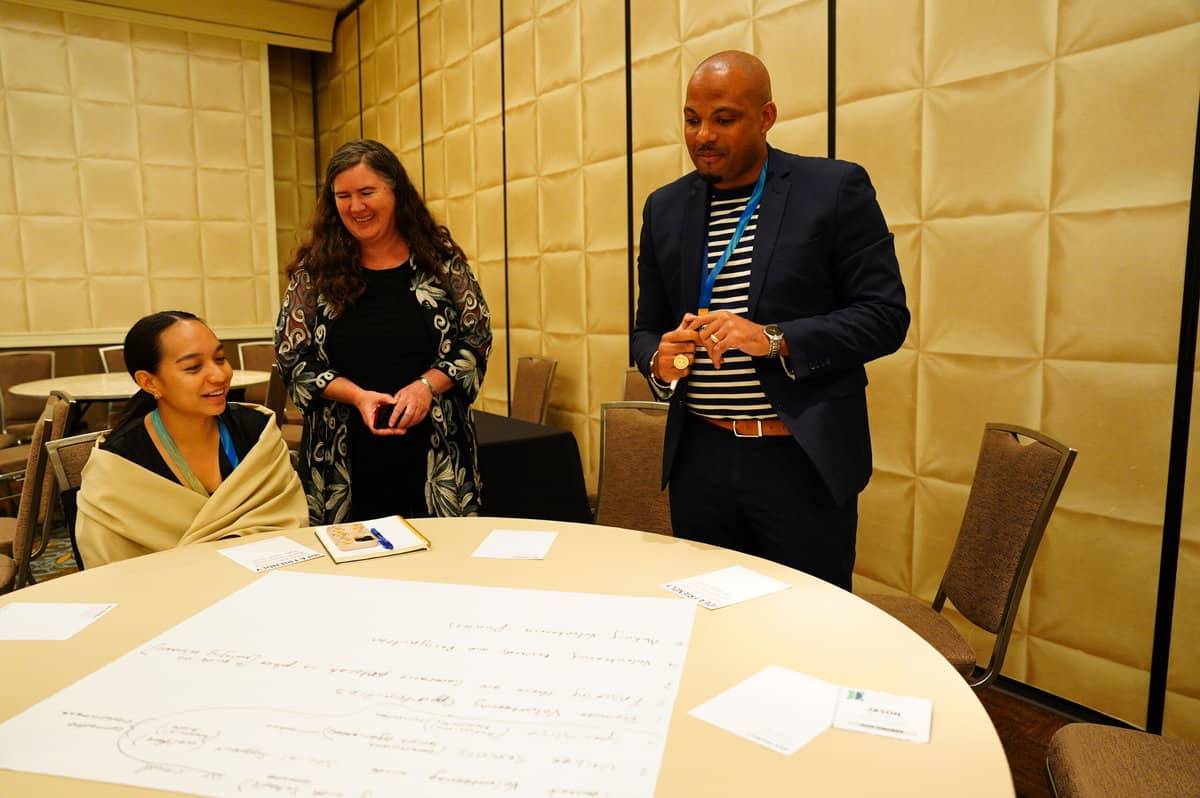
Photo courtesy of IEDC
What the Big Ideas were:
Challenge: Housing
Big Idea: Offsetting public infrastructure to incentivize private development
This idea brought to light the number of people who wanted help with a 12 unit housing development. The first small step they would take is to work with the economic development organization to find ways to bring the interested parties together for a conversation.
Challenge: Not enough volunteers
Big Idea: Volunteer engagement and involving the whole community
Their ideas included helping to promote all the possibilities for volunteering and creating a guide to managing volunteers ensuring any required government protocols are well explained. They created a brilliant tagline: making volunteering painless.
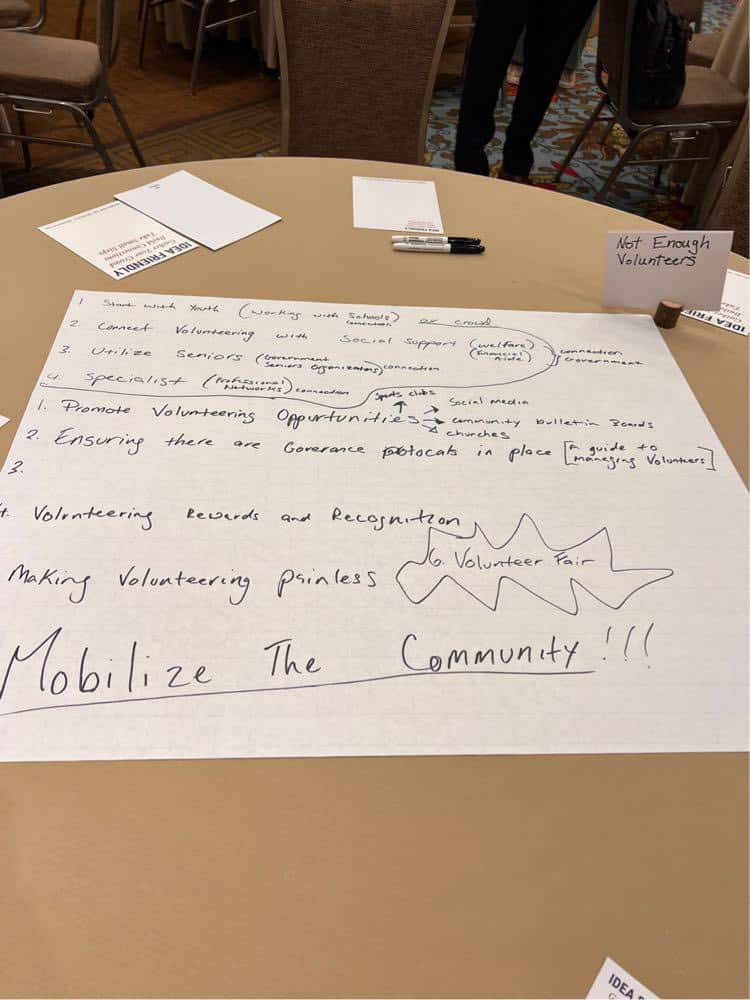
One attendee said to me, “Friend, I’m just a redneck from Alabama and I never get to meet people from other places. This was awesome!” Attendees came from the continental United States, Puerto Rico, Bermuda, Saipan, and Canada.
Challenge: Losing our young people
Big Idea: Helping youth boomerang back
This group was excited about working with different organizations and people to create a strong publicity campaign. This big idea uses storytelling and sharing the small wins with some catchy promotional pieces. “Wish you were here”, “While you were gone”, and “We’ve grown up” are some of the hooks to use in promoting the community to their audience of young people.
Big Idea: Downtown is dead
These folks took their big idea to fill the downtown and built out a list of who else wanted to work with them, and then built possible connections that could help get it done. They realized they were not alone and had others in their towns that wanted to help.
Challenge: Lack of childcare
Big Idea: Create a downtown childcare facility
After identifying a long list of people and organizations that would want to join this project, the group came up with the idea of playground “playdate” to bring them all together for productive discussion. They were excited to see how a new downtown childcare facility could not only improve the availability of childcare, but also spur downtown revitalization and contribute to positive placemaking.
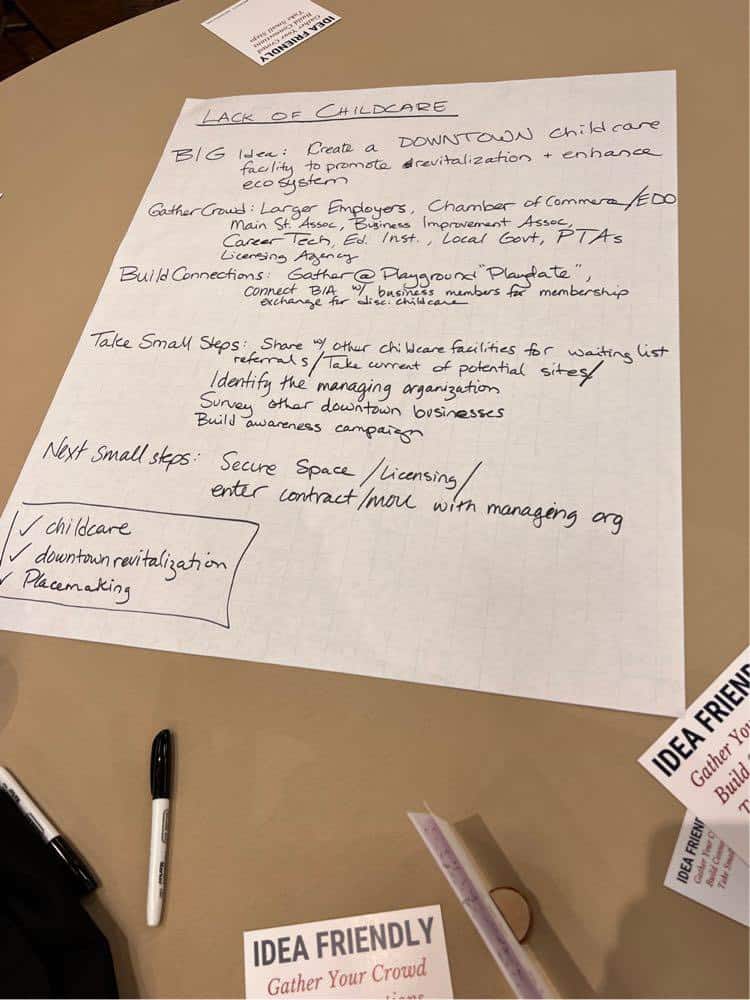
Creating Idea Friendly Projects is an easy to use and effective way to address our rural challenges.
This interactive IEDC session was a great success, and it was inspiring to see the plans the participants came up with to address the challenges they were facing. By working together and using innovative approaches, we can create more vibrant and resilient rural communities that are better equipped to face the challenges of the future.
“Thank you both so much for your preparation and execution of your session today! Sincerely, it was a true pleasure meeting and supporting you today. Your preparation and professionalism was reflected in your session. I appreciate your adaptability as well.”
Alexa Schultz, IEDC
Next steps:
- Reach out to SaveYour.Town about an Idea Friendly Workshop for your community or event
- Read more about the Idea Friendly Method.
- You can also watch a 24 minute Idea Friendly video for a $5 investment into your community.
- Don’t forget to sign up for our free weekly newsletter that addresses rural challenges!
Small town retail topics from IEDC conference: getting owners to improve their buildings, recruiting chain groceries and supporting local retail startups
I’m sharing notes from sessions and conversations at the International Economic Development Council annual conference in Dallas. First up: Retail! Lacy Beasley of Retail Strategies moderated a panel on retail real estate and development. While it was mostly big city stuff, several topics were relevant for smaller towns. How to convince a property owner to […]
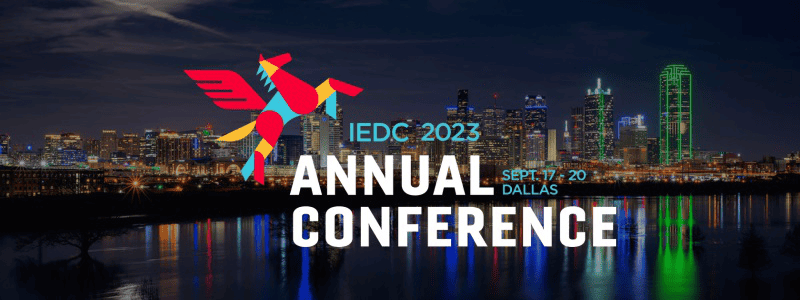
I’m sharing notes from sessions and conversations at the International Economic Development Council annual conference in Dallas. First up: Retail!
Lacy Beasley of Retail Strategies moderated a panel on retail real estate and development. While it was mostly big city stuff, several topics were relevant for smaller towns.
How to convince a property owner to reinvest in their retail strip, center or even one building in a small town
Herb Weitzman, a Dallas area retail developer, said that many retail real estate owners think ‘we’re not making any money so we can’t invest in our store or our shopping center.’
As a former rural retail store owner, I certainly recognized that small town, small business attitude.
However, Herb said that much like investment in remodeling and modernizing a retail store will increases its sales, it will also increase overall sales and the corresponding rents for retail centers. It’s possible that this is the right motivation to get some owners to act.
Small, rundown retail spaces can actually be a good long-term investment, Herb said. Buy them, fix them up and get a return.
For a small town, maybe it’s possible to find an outside investor who will purchase the rundown spaces, or to organize a coalition or cooperative of local investors to take it on.
One municipal official from a town of 50,000 people said they need to revitalize a dilapidated shopping center, but the owner will not reinvest in it. How can the city take a role?
Herb said that city governments often come to him to point out a possible deal, like revitalizing an existing center. They will help facilitate grant applications and other incentives to make the deal work.
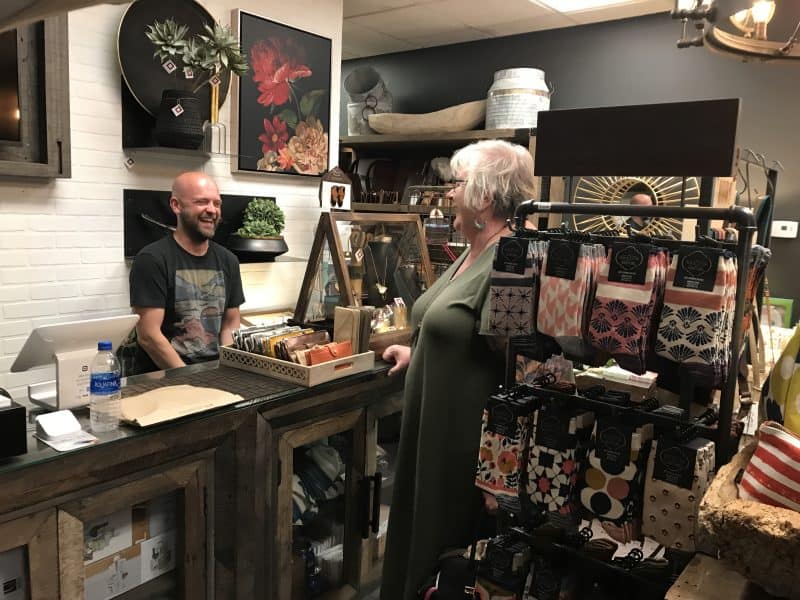
Local retail stores are key to rural and small town economic development. Photo by Becky McCray
Small town retail recruitment strengths: friendly, quick permitting
Herb said he likes working with “micromarkets,” which I took to be at least close to micropolitans with 10,000 up to 50,000 population. They are much smaller and much friendlier. You can sit down with them and work things out.
And that’s your hidden secret as a small town: you’re small, you work with people personally, and you’re friendly.
Panelist Christopher Walker with Raising Cane’s Chicken Fingers said that retail deals are taking longer in the 2020s, especially permitting. It takes them an average of 370 days in the western US to get a permit, 203 days in central US, and 320 days in the east.
One store started in 2020 took until 2023 to permit, Chris said. All that time, stores or restaurants are paying “dead rent” for space they can’t do anything with. Many times they have employees hired, but waiting and doing nothing.
Those numbers shocked me. How long does it take for your small town to issue a retail permit? A week or two? Maybe a couple of months at the most? Start considering that a competitive advantage. And be sure you are extending just as much support to locally-owned retail stores as you would to a chain you would recruit.
Recruiting chain grocery stores
Another audience member said that their grocery market is considered saturated in a retail study, but the stores they have are dirty and under-stocked. How can she tell that story to recruit a new grocery retailer?
Rita Williams with Kroger said to work through a retail broker if you want to recruit a national brand. The national chain retail grocery recruitment process takes 3 to 5 years from start to store.
If existing stores are being neglected by their chains, try to find out if any of those existing stores are planning to pull out, Rita said. That additional information may help get a retailer to look past the “saturated market” label.
Knowing that an existing store plans to pull out is critical for small town and rural markets. You may only have one store, and you will want to act immediately to organize a cooperative or community-owned grocery.
Importance of local retail
Find out what the community wants before acting, Rita said.
It feels obvious, but too often local leaders are pressured into quickly making large investments in retail recruitment or supporting an outside chain.
If you want to save your town, start your own small business.
If you want more reports from IEDC or more practical information for small towns, subscribe to SmallBizSurvival.
October is the new December: Shop early, shop indie local
Heads up, rural retailers: holiday shopping has already started! Guest post by Jen Risley, AMIBA Why promote Shop Indie Local early this holiday season? Because more of us are shopping early for holiday gifts. From National Retail Federation: Over the last decade, consumers have been kicking off their holiday shopping early in order to spread […]
Heads up, rural retailers: holiday shopping has already started!
Guest post by Jen Risley, AMIBA
Why promote Shop Indie Local early this holiday season? Because more of us are shopping early for holiday gifts.
From National Retail Federation:
Over the last decade, consumers have been kicking off their holiday shopping early in order to spread out their budgets and avoid the stress of holiday shopping. Continuing the trend [in 2022], 60% of holiday shoppers started browsing and buying by early November.
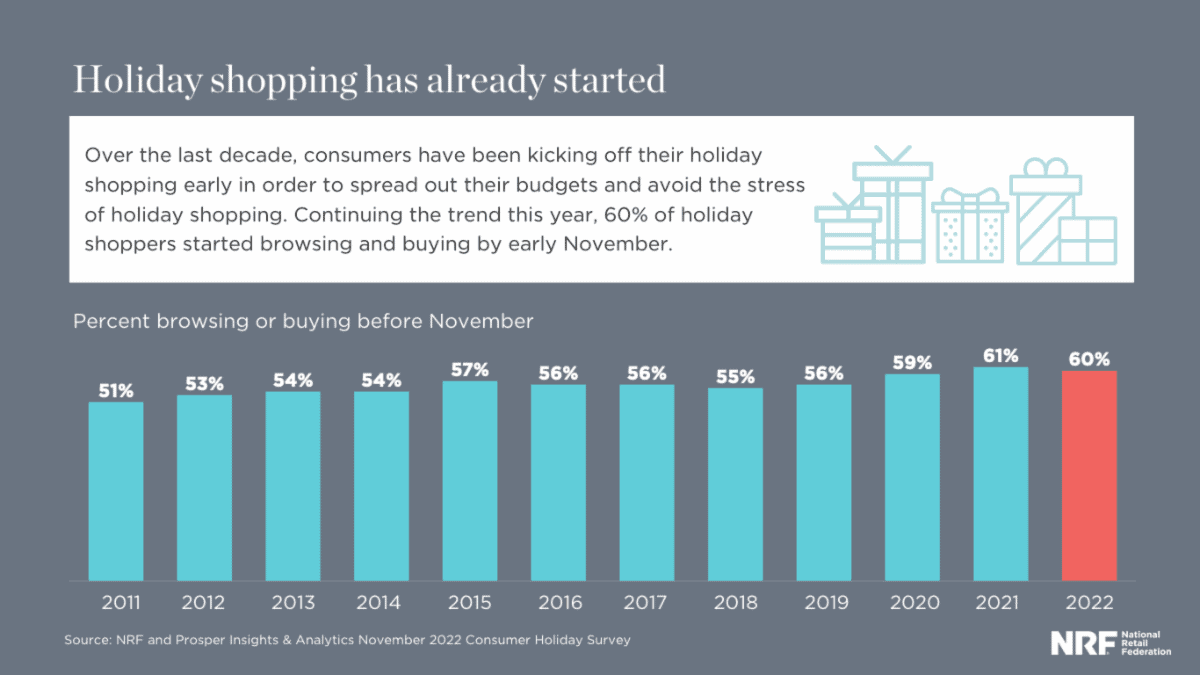
How to say it in your small business marketing
A good message to share with customers is something along the lines of “Let’s ensure that independent businesses have strong end-of-the-year sales by supporting them now.”
Here are some ways they can support not just your business, but all your local independent colleagues:
- Pre-order gifts and supplies today
- Buy a gift card
- Support local fundraising campaigns
- Donate to your community’s Independent Business Alliance
- Share on social media how much you love locally owned businesses (tag your post with #shopindielocal)
- Adapt and share these posts on social media
A huge thank you to the American Booksellers Association for creating the October is the New December campaign to boost the Shop Early, Shop Local message. Check out their campaign here.
Make your own social media graphics with the “Shop Early, Shop Indie Local” message, like this one from the American Booksellers Association:
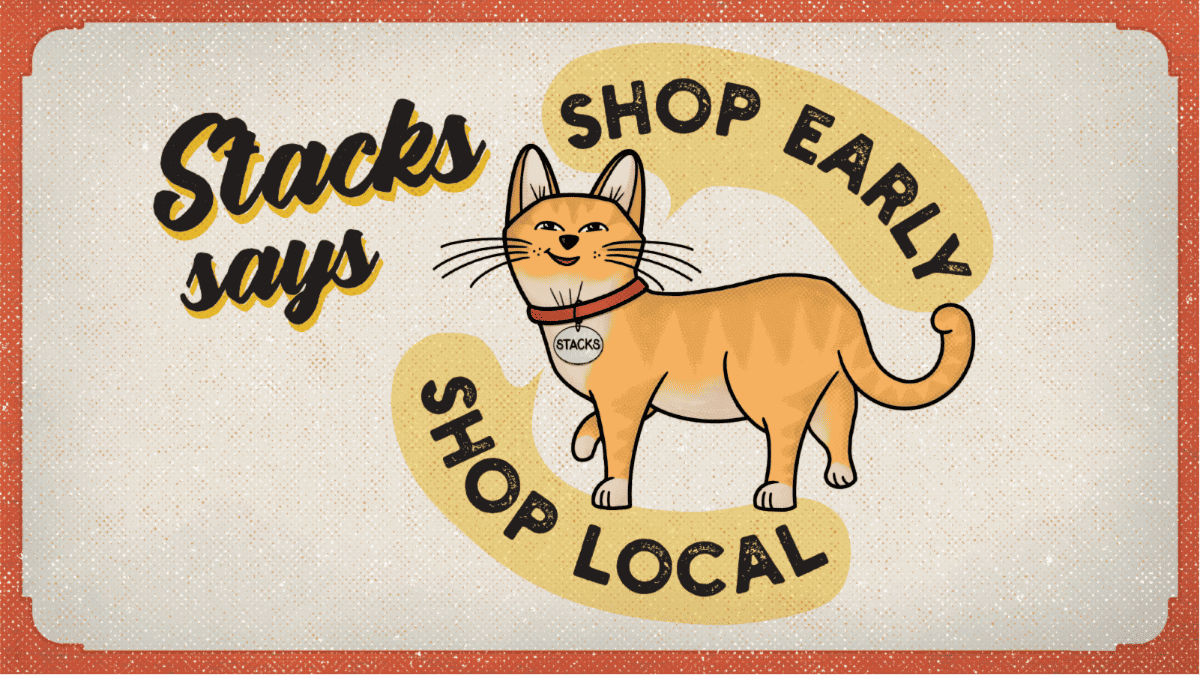
Stacks the bookstore cat says shop early, shop local.
Subscribe to SmallBizSurvival for more Shop Indie Local updates throughout the holidays.
Turn free advice requests into paying clients
Years ago, Thursday Bram asked me some questions about how freelancers and other consulting and professional folks can avoid giving away too much of their knowledge for free. Her article at Freelance Switch is no longer online, so I thought it was time to share it here, as well. Here’s some of my best advice […]
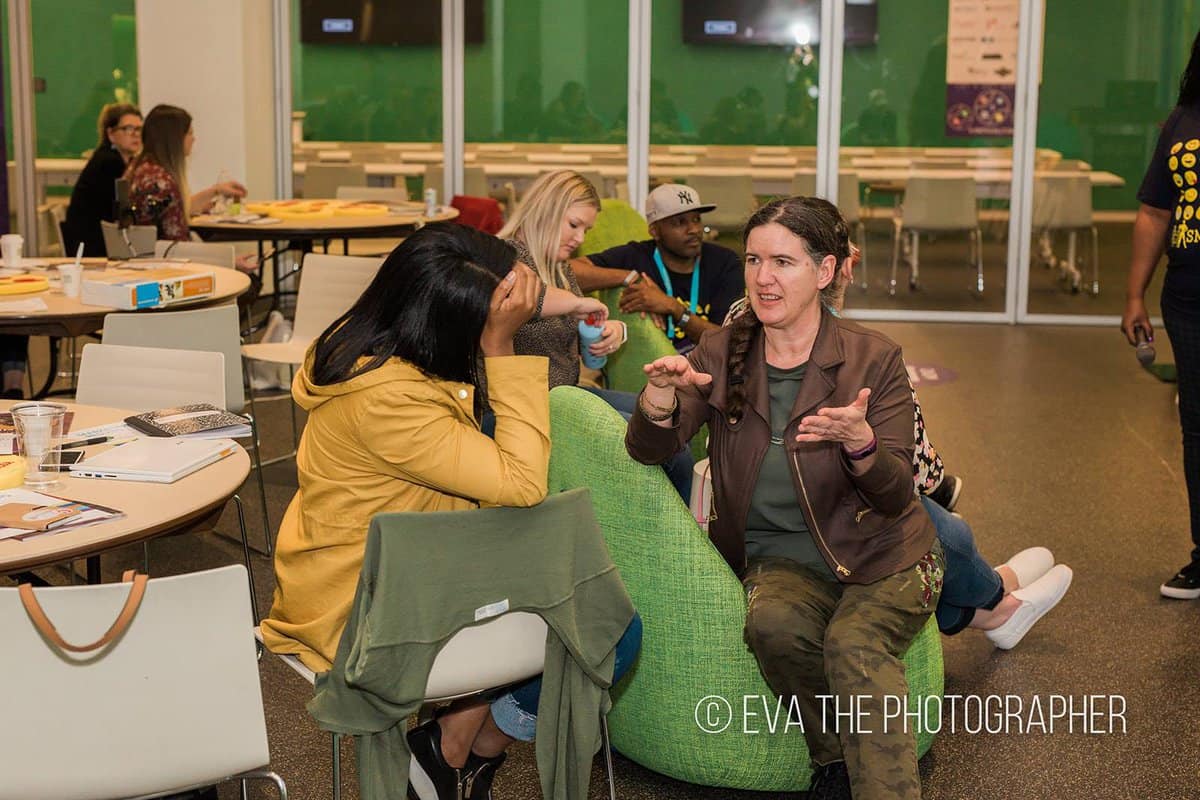
If we meet at a conference, I’ll be happy to give you some of my time. If you need more help, then it may be time for a coaching call. Photo (C) Eva the Photographer, courtesy of SMTulsa.
Years ago, Thursday Bram asked me some questions about how freelancers and other consulting and professional folks can avoid giving away too much of their knowledge for free. Her article at Freelance Switch is no longer online, so I thought it was time to share it here, as well.
Here’s some of my best advice on how to draw the line between free and paid conversations.
What is your reaction when someone asks to just ‘pick your brain’? Do you have a standard reaction that you use across the board or are there people that you’re more willing to talk to?
I decide how to handle people seeking free advice based on my existing relationship with them. Some people are close friends. I’ll help those folks more than someone who emails me out of the blue. Most of the questions seem to come from folks who don’t know me at all. So I try to assess the situation based on our relationship.
Do the people who just want to ask you questions typically turn into paying clients without much help from you?
It doesn’t happen by magic, you do need a strategy. And even then, not all of them will convert. Some are just freebies no matter what you do. I’m a collector of good phrases to use.
- Liz Strauss told me she would say, “If you’d like me to do that for you, I charge $XXX/hour.”
- Denise Wakeman said she will point people to her matching products already available. If someone asked her to look over their publication, she would give them the link to her sales page for a publication critique. Those products are really packaged services.
- Cathy Stucker would say, “I can spend ten minutes with you, and if you require more assistance I will be glad to schedule a consultation at my regular rates.”
- My colleague Deb Brown offers 15 minutes at no charge. When she gets on a call, she sets a timer. When it’s up she asks, “Do you want to go on with a paid conversation? That costs $XXX per hour.”
- Sheila Scarborough used to invite folks to talk with her at her weekly co-working session, Round Rock Jelly. If the question is more involved than can be answered there, it’s a consulting job.
- Jennifer Navarette told the story of meeting with a potential client in his office. He asked lots of questions. Finally, she stood up to come around the desk and reached for the keyboard. Her partner interrupted, “You do know that we just crossed into paid time?” he asked. “Oh, yes,” the prospect said, instantly converting to a paying client.
- Barry Moltz used to say, “time to turn on the meter.” (He’s from Chicago. Can you tell?)
Even with a special phrase in your arsenal, you still have to have a way for people to pay you.
What strategies have you used to turn this sort of person into a paying client? If it isn’t possible to do that, how do you keep this sort of person from wasting your time?
Offer them the help they need, but in a way that respects your valuable time. Here are three ideas of how to educate people on your own terms.
- Create a standard resource you give to people that want to do it themselves. Invest a few hours in creating a simple how-to booklet, paper or downloadable PDF, and save those hours you would normally spend trying to assist the freebie-seekers. You probably have all the info you need in your article or email archives.
- Do workshops. Charge a modest fee. Then Do-It-Yourself-ers can be encouraged to take the class, online or in person. This lets you group up the learners, help them all a certain amount, get paid for it, and allow some of them to see that they really do want professional help. Record the session. Then the next time you get hit up for more free advice, you can refer them to where they can purchase your workshop. Do NOT make this a pitch for your service. Do make it an honest useful training.
- Package your services into a defined product. Then charge for it. If you often get asked to look over someone’s plan, make that a service. Same with requests for help getting unstuck on a project. Once it’s a product, it’s easier to refer and sell.
- Set up a professional-looking place people can see your coaching or consulting offers. And give them a way to pay. They can’t buy something you aren’t actually selling. Use one of the many easy to use online learning platforms that lets you collect online payments.
You don’t have to charge everyone every time.
Decide in advance how much you want to reinvest in others. Maybe you’re happy to review a resume, reassure someone just getting started or spend some time with promising people in your area. Maybe you like to help at a conference whenever possible. That’s up to you.
Set you limits, and be ready to speak up for yourself.
The Allure of Authenticity: Rural stories can give your product a leg up
Why Rural Craftsmanship Resonates in Online Sales Guest post by Tance Hughes In today’s digital age, the online marketplace is bustling with options at every click. Amidst the buzz of big brands and flashy advertisements, there lies an understated yet profound power: the allure of authenticity. For rural entrepreneurs, this authenticity is rooted in their craft, […]
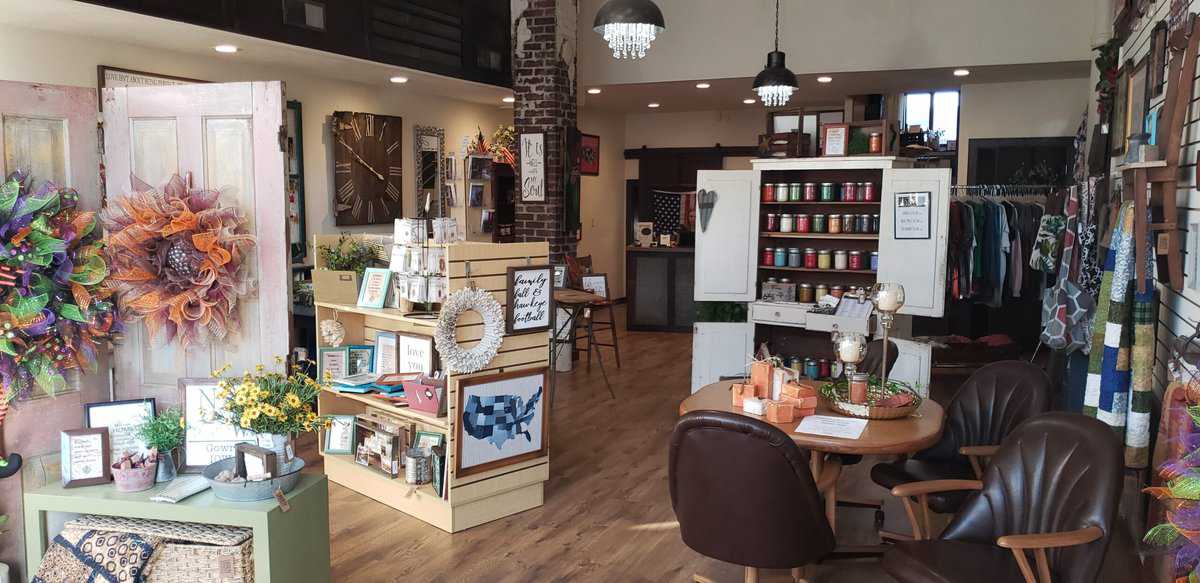
For rural entrepreneurs, authenticity is rooted in their craft, the traditions it stems from, and the genuine narratives behind each product. Photo by Deb Brown
Why Rural Craftsmanship Resonates in Online Sales
Guest post by Tance Hughes
In today’s digital age, the online marketplace is bustling with options at every click. Amidst the buzz of big brands and flashy advertisements, there lies an understated yet profound power: the allure of authenticity. For rural entrepreneurs, this authenticity is rooted in their craft, the traditions it stems from, and the genuine narratives behind each product.
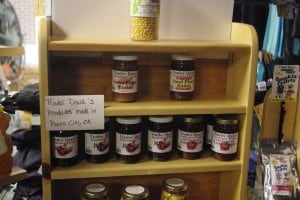
A jar of jam preserving the flavors of a bountiful summer harvest can embody more than mere utility.
Handcrafted Goods: Beyond Just a Product
Each handcrafted item carries with it a story of its origin. Whether it’s a quilt stitched during the quiet hours of a winter evening, or a jar of jam preserving the flavors of a bountiful summer harvest, these items embody more than mere utility. They represent hours of labor, generations of passed-down knowledge, and a deep connection to the land and community.
When consumers purchase these goods, they’re not just buying a product; they’re buying a slice of history, a tale of dedication, and a bond with the artisan. This level of personal connection is something mass-produced items often lack, no matter how high their quality might be.
Telling the Tale: Narratives That Captivate
For rural entrepreneurs looking to stand out in the online market, the key is to emphasize these narratives. Detailed product descriptions that talk about the craftsmanship, the traditions that inspired the product, or even anecdotes about its creation can captivate a potential buyer’s imagination. High-quality photos and videos, showcasing the product in its natural rural setting or in the process of being made, can further enhance this narrative.
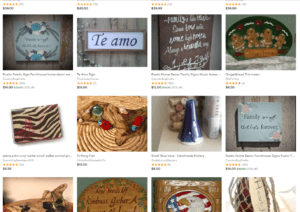
Platforms like Etsy or ArtFire thrive because they promise products imbued with authenticity.
The Modern Consumer: Seeking Genuine Connections
Modern consumers, bombarded by generic advertising and overwhelmed by choices, are increasingly drawn to authentic experiences and products. A survey by Cohn & Wolfe found that 91% of global consumers value honesty from brands most. This means that rural artisans, with their genuine products, have a competitive edge. Their offerings stand as a beacon of genuineness in an oversaturated market.
Moreover, the rise of platforms like Etsy or ArtFire, which specifically cater to handmade and vintage goods, attests to this growing consumer trend. These platforms thrive because they promise products imbued with authenticity.
What Does This Mean For Me?
The digital marketplace might seem vast and impersonal, but therein lies an opportunity for rural entrepreneurs. By leveraging the inherent authenticity of their crafts and effectively communicating the stories behind each product, they can forge deep connections with consumers. In an era where genuineness is increasingly cherished, rural craftsmanship is not just a relic of the past but a vibrant force shaping the future of online sales.
About the guest author
Tance Hughes is The Ruralpreneur, empowering small town entrepreneurs to expand their product-based businesses through e-commerce. Sign up for his regular newsletter at The Ruralpreneur.
Get started as an outdoor outfitter without breaking the bank
Our latest Survey of Rural Challenges said natural resources are rural communities’ best rural assets, but most places don’t have enough outfitters to take advantage of them as tourism development. Here’s how rural people like you can take small steps to grow into outdoor outfitters. Gather Your Crowd to attract groups and organizations that want to help […]
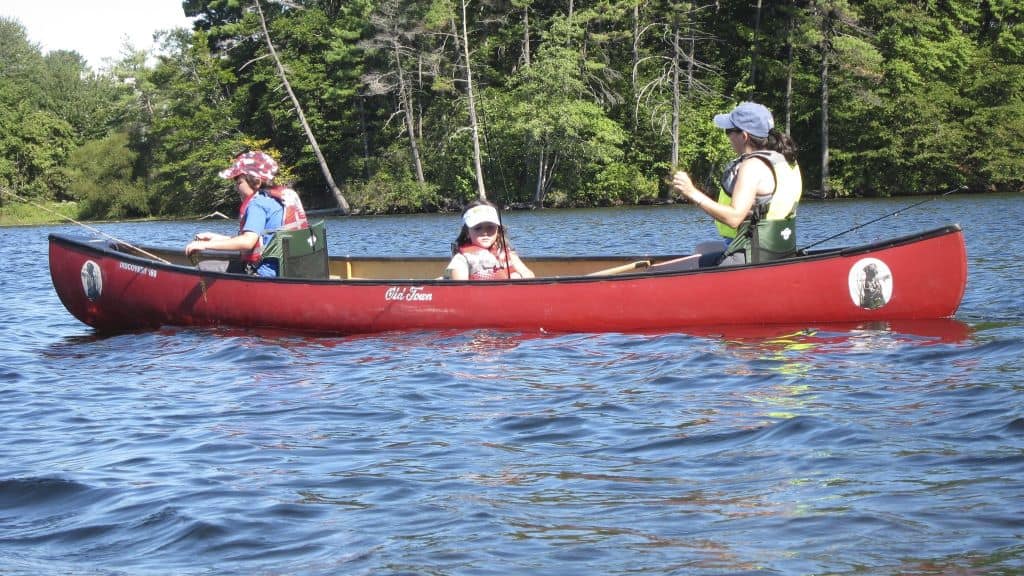
Kids in a canoe photo (CC) by CC Chapman
Our latest Survey of Rural Challenges said natural resources are rural communities’ best rural assets, but most places don’t have enough outfitters to take advantage of them as tourism development.
Here’s how rural people like you can take small steps to grow into outdoor outfitters.
- Gather Your Crowd to attract groups and organizations that want to help
- Build Connections to borrow equipment and acquire insurance
- Take Small Steps by splitting the work with different businesses and organizations in the community.
Both Deb and I visited Eastern Kentucky last year. I visited Estill County, and Deb was in Jackson County. We each shared a version of this process to help get tourism ideas off the ground.
Ask around, others may help
Kathy from Jackson County wanted to start her own outdoor business but she only had one side by side ATV to use. Then another person offered a canoe for Kathy to rent out. This started a conversation around the room of how she could start now, using what others offer and they would help her too.
Small steps to take now
In Estill County, we sketched out the steps to grow their own outfitters for river and forest recreation. Here are some of the key steps:
- Talk to an existing outfitter in a similar area from the surrounding communities. Ask lots of questions.
- Find local outdoor recreation groups. Their members might be good potential operators, partners or customers.
- Consider covering startup costs with Sponsor-A-Canoe with local business logos or wraps.
- Cover insurance costs by finding a sponsor or getting a discount through the chamber or organizations like the American Canoe Association.
- Break up all the parts of the business and find a person or group to manage or run each part. One group might own the canoes, another has a trailer and can handle payroll, another might volunteer for part of the work during startup.
It’s not as traditional as starting all at once with a business plan and lots of debt, but it’s more of the rural approach. We’re used to making do and making things work.
